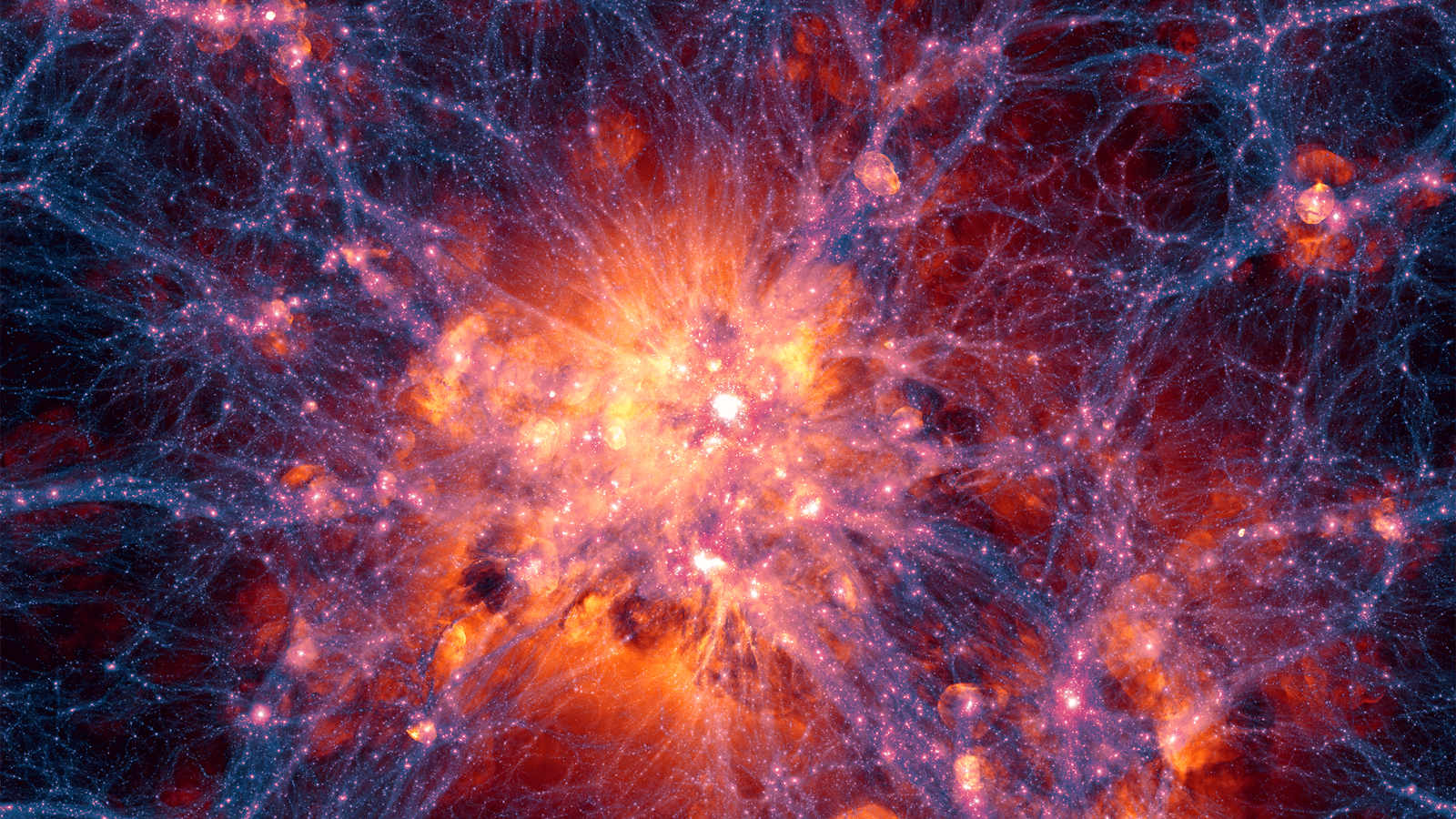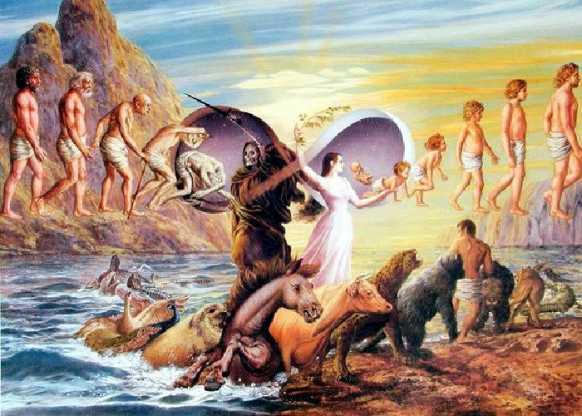- In physics, string theory is a theoretical framework in which the pointlike particles of particle physics are replaced by one dimensional objects called strings. It describes how these strings propagate through space and interact with each other.
- On distance scales larger than the string scale, a string looks just like an ordinary particle, with its mass, charge, and other properties determined by the vibrational state of the string. In string theory, one of the many vibrational states of the string corresponds to the graviton, a quantum mechanical particle that carries gravitational force.
- Thus string theory is a theory of quantum gravity. String theory is a broad and varied subject that attempts to address a number of deep questions of fundamental physics. String theory has been applied to a variety of problems in black hole physics, early universe cosmology, nuclear physics, and condensed matter physics, and it has stimulated a number of major developments in pure mathematics.
- Because string theory potentially provides a unified description of gravity and particle physics, it is a candidate for a theory of everything, a selfcontained mathematical model that describes all fundamental forces and forms of matter. Despite much work on these problems, it is not known to what extent string theory describes the real world or how much freedom the theory allows to choose the details.
- String theory was first studied in the late 1960s as a theory of the strong nuclear force, before being abandoned in favor of quantum chromodynamics.Subsequently, it was realized that the very properties that made string theory unsuitable as a theory of nuclear physics made it a promising candidate for a quantum theory of gravity. The earliest version of string theory, bosonic string theory, incorporated only the class of particles known as bosons. It later developed into superstring theory, which posits a connection called supersymmetry between bosons and the class of particles called fermions.
- Five consistent versions of superstring theory were developed before it was conjectured in the mid1990s that they were all different limiting cases of a single theory in eleven dimensions known as Mtheory.
- In late 1997, theorists discovered an important relationship called the AdS/CFT correspondence, which relates string theory to another type of physical theory called a quantum field theory.
String theory arrived in the public field in 1988 when a BBC
radio series Desperately Seeking Superstrings was aired. Thanks to good
marketing and its naturally curious name and characteristics, it is now part of
popular discourse, mentioned in TV’s Big Bang Theory, Woody Allen stories, and
countless science documentaries.
But what is string theory and why does it find itself
covered in controversy?
Life, the universe
and the theory of everything:
Today we think of string theory in two ways. It’s understood
as a theory of everything – that is, a theory that purposes to explain all four
forces of nature within a single hypothetical scheme.
These forces are:
- Electromagnetic force
- Gravitational force
- Weak nuclear force
- Strong nuclear force.
Electromagnetism and gravity are acquainted to most people.
The nuclear forces happen at a subatomic level and are invisible to the naked
eye. String theory is also utilized to explain quantum gravity, a theory that
joins Einstein’s theory of gravity and the principles of quantum theory.
Tangled beginnings:
But string theory started life more humbly, as a way to
define strongly interacting particles called hadrons. Hadrons are now known to
be made of quarks linked with gluons but string theory observed them as quarks
joined by strings (tubes of energy).
Understood this way, string theory buckled under both new
experimental proof (leading to the highest of quantum chromodynamics which
describes the connections of quarks and gluons) and also internal problems.
String theory involved too many particles, as well as a massless particle with
so-called spin 2 – spin being the name used for the angular momentum of
particles. As it occurs, this is precisely the property possessed by the
graviton – the transporter of gravitational force in the particle physics
picture of the world.
Beyond four
dimensions:
This finding meant that with a bit of skilful rebranding
(and rescaling the energy of the strings to contest the strength of
gravitation), string theory shed its hadronic past and was born-again as a
quantum theory of gravity. All those other particles that were also difficult
for the original string theory were capable of capturing the remaining
non-gravitational forces too. This is how string theory took on its present
role as describing all four forces together: a theory of everything.
But it could not shed many of its curious features. One such
feature was the need of many more space-time dimensions than are really seen.
In a “bosonic” form of string theory (i.e. without matter or
fermions, there would have to be 21 dimensions – 20 space dimensions and one
time dimension. In a theory with fermions, there would have to be nine space
dimensions and one temporal, ten dimensions all together. The problem is that
we only observe four dimensions: height, width, depth (all spatial) and time (temporal).
Supersizing symmetry,
downsizing dimensions:
The “super” in “superstring theory” refers to symmetry,
known as supersymmetry, connecting bosons and fermions. There are five probable
theories that include matter in ten dimensions. This was formerly taken as a
problem since it was projected that a theory of everything should be unique.
The six hidden dimensions (ten minus the four dimensions of everyday life) are
made too small to be seen, using a process known as compactification.
Beautiful Maths:
It is from this process that much of the extremely beautiful
(and cruelly difficult) mathematics involved in string theory stems. We have no
problem thinking of each occasion in the world as labelled by four numbers or
coordinates (e.g., x,y,z,t). A string-theoretic world adds another six
coordinates, only they are wrinkled into a tiny space of radius related to the
string length, so we do not see them.
But, according to string theory, their influence can be
observed indirectly by the way strings moving through spacetime will wrap
around those crumpled, curled up directions. There are very many ways of
concealing those six dimensions, yielding more probable stringy worlds
(possibly as many as 10500!).
How long is a piece
of string?
This is why string theory is so controversial. It apparently
loses all predictive power since we have no way of separating our world between
this plenitude. And what good is a scientific theory if it cannot make
predictions?
One response is to say that these numerous theories are not
in fact so different. In fact there are all sorts of strict relations known as
dualities connecting them. More current progresses based on these dualities
include a new type of object with higher dimensions – so called Dp-branes.
These too can wrap around the dense dimensions to make possibly visible effects
Most outstandingly, they can also deliver boundaries on
which endpoints of strings sit. Just to confuse things more, a new kind of
theory has been found, this time in 11 dimensions: 11 dimensional supergravity
- it is also very attractive mathematically.
Dial M for
Multiverse:
String theorists are fond of saying that these six theories
are features (special limits) of a deeper fundamental theory, known as
M-theory. In this way, individuality is restored.
Or is it?
We still have the spectre of the 10500 solutions or worlds.
The great hope is that the numeral solutions with features like our own world’s
(with its four noticeable dimensions, particles of numerous types interacting
with particular strengths, conscious observers, and so on) will be small enough
to be capable of extracting testable predictions.
So far, though, the only actual way of getting our world out
of the theory includes the use of a multiverse (a realistically interpreted ensemble
of string theoretic worlds with differing physical properties) joint with the
anthropic principle (only some of these worlds have what it takes to support
humans).
Unnecessary to say, this does not completely sit easy with
critics of string theory!
But string theory has been making strides in other areas of
physics, remarkably in the physics of plasmas and of superconductors. Whether
this success can be repeated within its proper realm (fundamental physics)
remains to be seen.













































/https://public-media.smithsonianmag.com/filer/db/c4/dbc4cd8b-b4b3-4a28-b211-42bc49a87a11/42-46205410.jpg)
